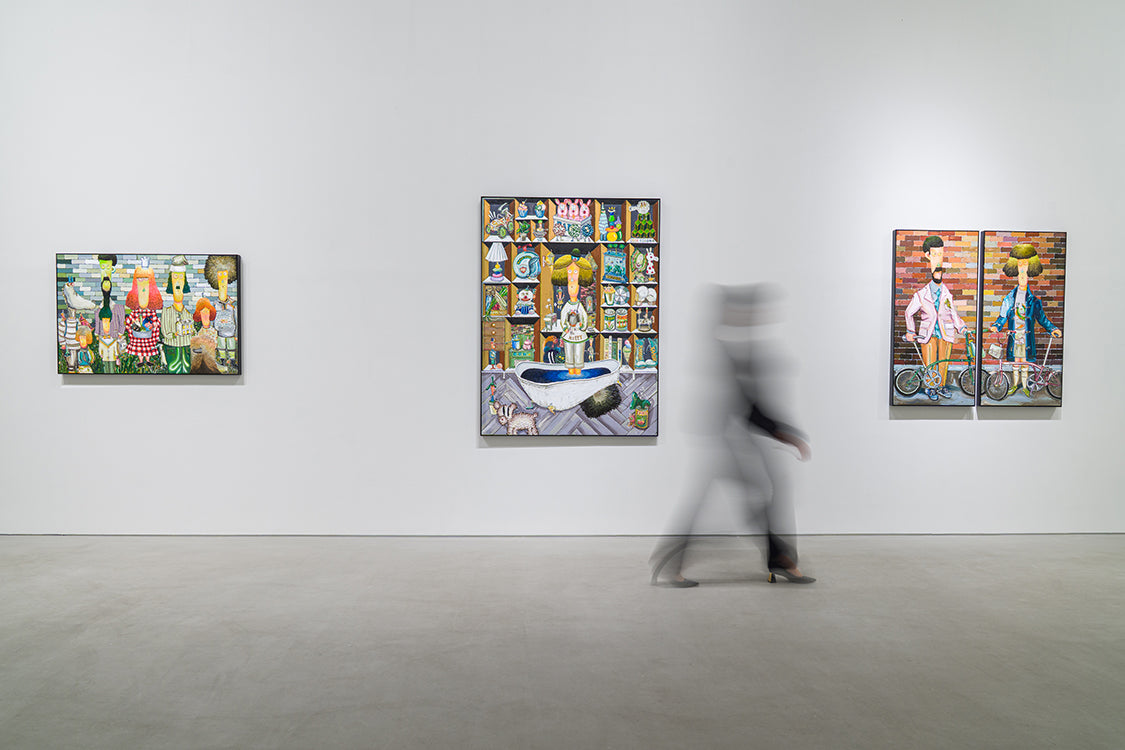ARTICLES
A Portrait of Hope and Empathy: Interview with Lee Jaehyun
2025.04.25
INTERVIEW

With raised brushstrokes and endearing, character-like figures, the background is filled with objects that evoke the image of a toy box.
Through this interview, we delve into the thoughts embedded in Lee Jaehyun’s work, the journey that led her here, and the sources of her imagery.
From Toys to Textures: Crafting Identity in Brushstrokes

The fine brushstrokes in the hair can be seen
- Your works are characterized by distinctive brushstrokes, particularly in the depiction of character-like figures and hair. What influenced the development of this unique visual language?
Lee: The figures in my works are the result of projecting my emotions and inner self as an adult onto meaningful objects and toys from my childhood.
The thick layers of paint are created using sculptural techniques of carving and assembling, employing special materials and tools I made myself.
This approach stems from my contemplation on how to bring three-dimensional sculptural qualities into painting, and I ultimately used the impasto technique to express visual imagery.
In particular, the contrast between the flat faces and the voluminous hair is meant to portray a natural relationship between restraint and freedom, intentionality and spontaneity.
Where Memory Meets Empathy

Whitestone Gallery Seoul
- Where do you draw inspiration from?
Lee: I would say I draw inspiration from things unrelated to art.
I incorporate memories from the past and scenes from daily life. Things that may not seem artistic at first and layer my own imagination onto them in my work.
- Could you share the key elements and artistic approach you prioritize in your creative process?
Lee: Communication and empathy between the artist and the viewer are of utmost importance to me. I try to draw out both my own lived experiences and those of the audience to form a connection and a shared sense of understanding. I break people and objects down into brief frames of memory and extract emotions such as inner solitude and loneliness to create my works.
Toward the Future, Through the Self

Whitestone Gallery Seoul
- What is the underlying concept behind the key visual of this exhibition?
Lee: Be Like expresses, through imagination, the lyrical self of the artist who wishes to be like someone else and the desire to communicate with the audience. By presenting scenes from everyday life that reflect the coexistence and interdependence of modern individuals. Something everyone can relate to.I tried to convey the meaning of existence and the reason we continue to live.
- Your earlier works were deeply rooted in recollections of the past. What prompted the shift in perspective toward envisioning the future?
Lee: While painting my childhood, I found myself healing in the process. Expanding beyond personal memories and reflections, I began to view my practice as a way to convey comfort to others through my art.
By first imagining and anticipating the future, I use my painting to wait for the viewer—and to connect with them on an emotional level.
A Path Eventually Found: A Journey into Art

Whitestone Gallery Seoul
- What inspired your journey as an artist?
Lee: In second grade, I begged my parents to let me attend art school because I wanted to draw. Through classes with crayons and paints, I began to dream of becoming an artist.
Although I later faced the reality of how difficult that path could be, I eventually found my way back and made it happen.
I don’t believe one needs a particular moment to pursue art. It depends on how strongly you desire it.
The path of an artist is fate. Even if forgotten for a time, you will find art again, as if by instinct.
- What motivated you to expand your artistic practice from sculpture to painting?
Lee: Sculpture has the advantage of being able to represent form in three dimensions, but I felt limited in expressing backgrounds, materials, and color through it.
To overcome this, I sought to integrate the strengths of both sculpture and painting, and ultimately expanded my practice into painting as a complementary form of expression.

Whitestone Gallery Seoul
Lee Jaehyun’s painting practice, shaped through sculptural techniques, reflects a sincere desire to connect with others through form.
The imagination of wanting to be like someone overlaps with the very act of depicting the self, reaching viewers as empathy and healing.